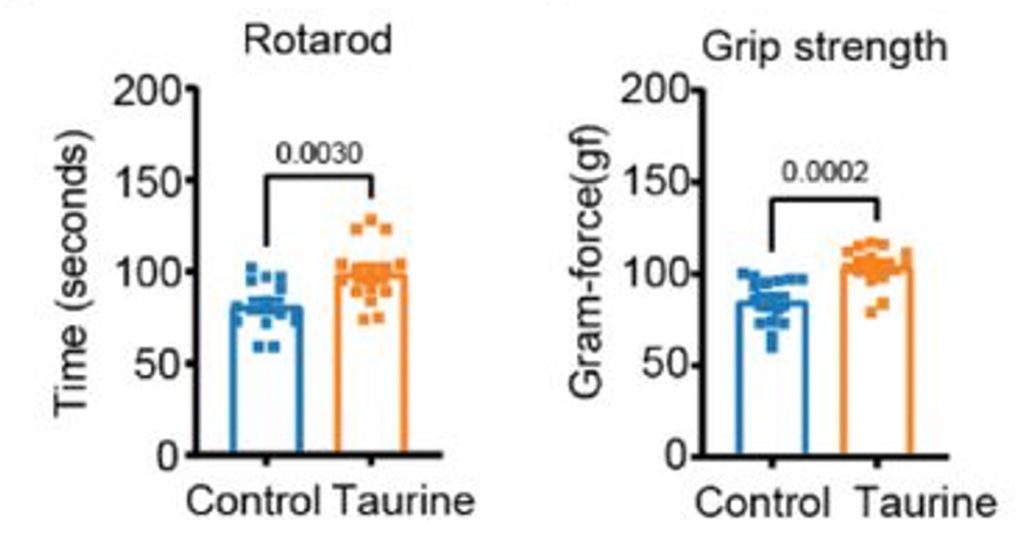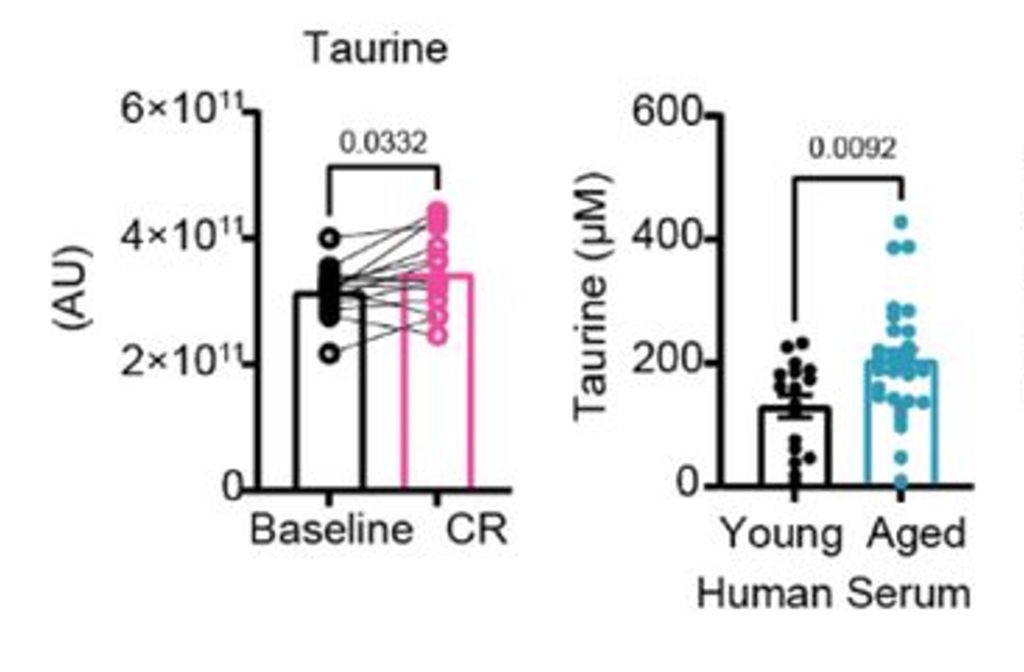Unlock Better Balance, Strength & Less Inflammation with Taurine: Yale Research
Supplementing with taurine, a naturally occurring amino acid, improves the strength, balance, and metabolic health of older mice while reducing inflammation.
Highlights
- Taurine improves the strength, balance, and coordination of older mice while reducing inflammation.
- Taurine is elevated in calorically restricted and aged humans.
- Taurine reduces inflammation by inhibiting a multi-protein structure called an inflammasome.
Taurine, often found in energy drinks, is a non-essential amino acid that functions to maintain fluid levels within cells. Recently shown to prolong the lifespan of mice, taurine is now considered a potential human anti-aging compound. Whether taurine maintains its “anti-aging” title will require further scientific examination, which is what researchers from Yale University did in a new pre-print. Their findings add to the repertoire of taurine’s pro-longevity properties.
Taurine Improves the Health of Older Mice
To explore the anti-aging effects of taurine, the Yale researchers placed 8 g/kg of taurine into the drinking water of 20-month-old mice, roughly equivalent to 60-year-old humans. After 4 months, the concentration of taurine in the blood and liver of the mice doubled, confirming the efficacy of supplementation. Supplementation also reduced body weight and fat without reducing lean mass, demonstrating an improvement in body composition.
Consistent with the improvement in body composition, the mice treated with taurine also had lower glucose levels, suggesting improvement in metabolic health. Moreover, taurine improved the older mice’s balance and coordination, as assessed by how long the mice could run on a rotating rod. The grip strength of the older mice was also improved, suggesting that taurine counteracts frailty, a term used to describe an increased vulnerability to age-related decline, including muscle decline.

Taurine Is Elevated in Calorically Restricted and Aged Humans
A previous Duke University study showed that healthy young and middle-aged adults who, on average, consumed 12% fewer calories exhibited improved markers of cardiovascular and metabolic health, including reduced inflammation. To determine what could account for this reduced inflammation, the Yale scientists measured metabolites from the fat tissue of the Duke study participants. To their surprise, the Yale researchers found that taurine was among the top metabolites elevated by caloric restriction (consuming fewer calories).
Considering that caloric restriction has repeatedly been shown to prolong the lifespan of animals, the Yale scientists assumed that, since elevated levels of taurine are associated with longevity, older individuals must have lower taurine levels. Indeed, a previous study by Singh and colleagues showed that taurine levels are reduced in older individuals. However, in contrast, the Yale researchers found that taurine levels are elevated in older individuals. The reasons for this are unclear, but these findings led the Yale researchers to believe that elevations in taurine are an adaptive and beneficial response to stress.

How Taurine Reduces Inflammation
Age-related conditions, like cardiovascular disease, neurodegenerative disorders, and cancer, are linked to chronically elevated levels of inflammation. Considered a master regulator of chronic inflammation is a structure called the NLRP3 inflammasome. The activation of the NLRP3 inflammasome leads to a reduction in NAD+, among other cellular changes that contribute to age-related chronic diseases.
Scientists are interested in the NLRP3 inflammasome because it can be activated by multiple “danger signals,” which are molecules released by damaged cells that trigger an immune response. One example of a danger signal is ATP, the molecule our cells utilize for energy. Another example is endotoxin, which is a component of bacteria.

To examine how taurine affects inflammation, the Yale scientists activated the NLRP3 inflammasome of immune cells using various danger signals, including ATP and endotoxin. Interestingly, they found that NLRP3 activation caused taurine to leave the immune cells, reducing taurine levels within the cells. However, restoring taurine levels within the immune cells inhibited NLRP3 activation. NLRP3 is known to be activated when a cell shrinks due to lower levels of solutes (e.g., taurine). Thus, it appears that taurine reduces inflammation, at least in part, by blocking cell shrinkage and NLRP3 activation.
“These findings demonstrate that taurine is an upstream metabolic sensor of cellular perturbations that control NLRP3 inflammasome and lowers age-related inflammation,” said the authors.
Supplementing with Taurine
The authors of the study conclude that increases in taurine are a beneficial stress response to CR and aging. They say the reasons for Singh and colleagues showing that taurine levels decline with age in humans are unclear, speculating the possibility that their serum samples were contaminated with immune cells, which contain high levels of taurine. A third study measuring serum taurine levels from humans should help to confirm whether taurine levels drop or increase with age.
Assuming that taurine levels increase with age to protect against inflammation, the question is whether supplementing with more taurine is beneficial. Additional studies are needed to answer this question, but supplementing with taurine may alleviate the energy expended by cells to produce taurine, which could be beneficial.
Singh and colleagues showed that 1 g/kg of taurine extended the lifespan of mice by about 11%, while the Yale researchers showed that 8 g/kg of taurine improved balance, coordination, and strength. These studies suggest that supplementing with between 1 and 8 g/kg of taurine could counteract signs of aging. Still, there are no human studies showing that supplementing with taurine counters aging.
The Yale study also highlights that CR, which is known to have anti-aging effects and improve the metabolic health of humans, elevates taurine levels. Thus, if one were to choose between a taurine supplement and CR, CR is probably the best bet when it comes to improving health.
Model: 20-month-old C57BL/6 mice
Dosage: 8 g/kg/day of taurine for 4 months

